|
|
|
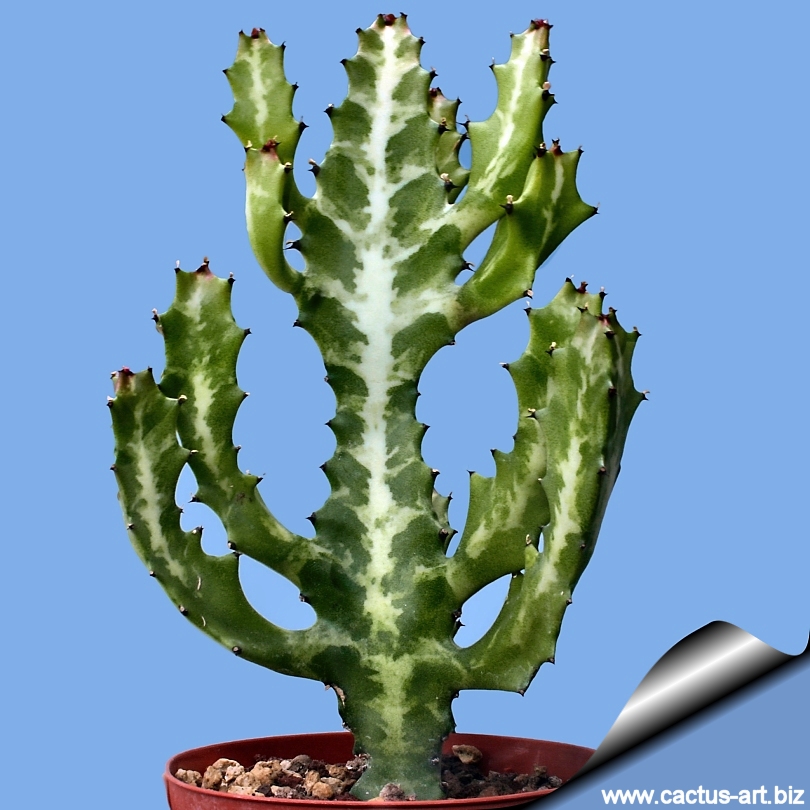
Euphorbia lactea
This is a shiny-surfaced, many branched, 3-sided, succulent
markedly banded with very ornamental whitish and green marbled
marking.
|
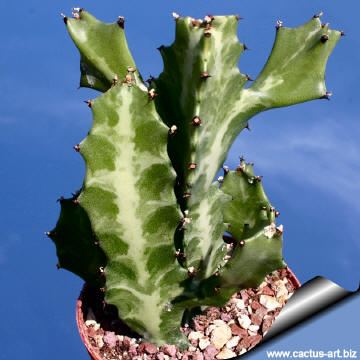 |
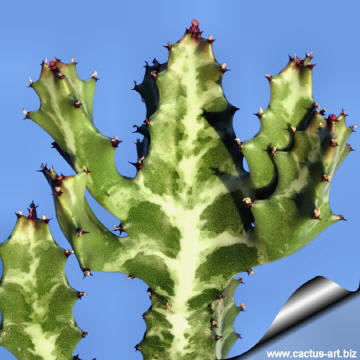 |
|
. |
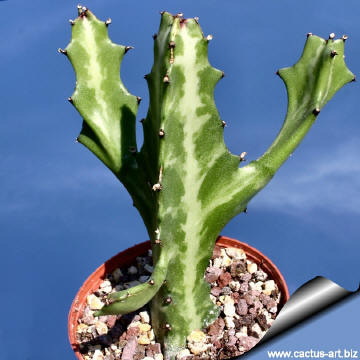 |
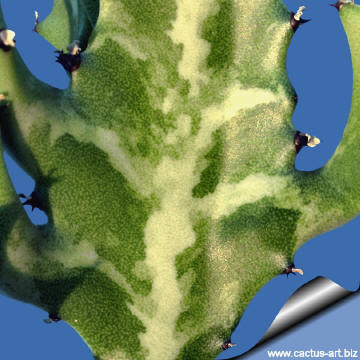 |
Warning: As with all other Euphorbias when a plant get damaged it
exudes a thick white milky sap known as latex. This latex is
poisonous and particularly dangerous for the eyes, skin and mucous
membranes. So pay extreme attention not to get any in your eyes or
mouth. Cultivated plants must be handled carefully. |
|


Advertising
|
|
|
|
|
Family:
Euphorbiaceae
Scientific name:
Euphorbia lactea Haworth
In: Synops. Pl. Succ. 127, 1812
Origin: Grows wild, in tropical
Asia. Widely cultivated in west Indies, Florida and in many tropical
areas world wide. Widely escaped from cultivation and in many places
forming dense thickets.
Conservation status: Listed in
CITES appendix 2.
Common Names include: Dragoon bones tree, Dragon bones,
Candelabra spurge, Candelabra Cactus, Cactus Candelabre, Caper Spurge,
Candle-stick tree,
Synonyms:
- Euphorbia lactea Rouxburgh 1832
(Non. Illeg.,Art. 53.1)
|
|
Description: A tall,
dark-green, many-branched, spinous milky-juiced shrub, with distinctive
silhouette that grow up to over 3-6 m tall (or more) but rarely does in
cultivation.
Stems: Erect, approx 5 cm in diameter, constricted into oblong
green segments. Centre of the segments conspicuously pale often with
very ornamental whitish and lime green marbled marking.
Ribs: 3(or 4) slightly winged, sinuate.
Leaves: It have have only the tiniest hint of leaves at the
growing tips in summer. The leaves are rudimentary, circular, reddish,
up to 3 mm in diameter, sessile, deciduous,
Stipular spines: Tiny but sharp, paired, widely divergent along
the margins, 2-6 mm long.
This is a highly variable species with several forms and hybrids
making precise descriptions of it difficult. Among them:
- E. lactea 'Ghost' form With
nearly white stems.
- E. lactea 'giant' form Large stemmed
- E. lactea 'crested' forms There are several and
variously coloured crested forms mainly selected by Asian growers.
|
|
|
|
Culture: Euphorbia
lactea is only hardy to maybe 5° C and most grow it either in
pots (excellent potted plant) or plant it in very protected locations.
Euphorbia lactea being from a tropical climate, it is one
of the few columnar Euphorbias that do exceptionally well in very wet,
humid climates. It need bright light to partial shade for best
appearance (but the variegated forms do best if protected from strong
sunshine in the hottest hours of the day). It responds well to warmth,
with its active growth period in the late spring and summer months.
Water thoroughly when soil is dry to the touch during active growing
season (more than once a week during hot weather) In the winter months,
waterigs should be suspended or restricted to once over the winter. The
most common failure in growing this plant is over watering, especially
during the winter months. Likes porous soil with adequate drainage.
Succulent Euphorbias in greenhouses apparently are seldom affected by
fungous diseases.
The Ghost form can be badly burned
in direct sunlight, though acclimating it to morning sun is not
difficult. This is a slow growing plant, though the cristate forms seem
particularly slow growing. Cristate forms are usually grown as grafted
plants and that may have something to do with their slow growth rate.
Reproduction: It is propagated by cuttings, while the
variegated and crested forms are difficult to grow on their own roots,
and are generally grafted for convenience on
Euphorbia canariensis or
Euphorbia resinifera.
It is recommend taking Euphorbia cuttings in Spring/Summer when the
plant is growing so that they have a better chance of success. They key
is heat & good air circulation. These cuttings should be dipped in
Hormone powder (but it is not needed) and left for a period of 3-4 weeks
to callous. Then pot the cutting and don't water ( or kept slightly
moist) until rooted. These will root just fine, if you can put the pot
outside in the summer, or put pot on a heating pad.
Uses:
It is a fency plant that makes very thick-set hedges, it is also used in
traditional medicine against, in warts and tumor.
Photo of conspecific
taxa, varieties, forms and cultivars of Euphorbia lactea.
|
|